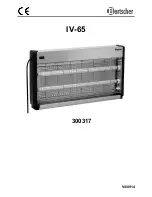
7 / 39
FISIOLASER IRD/IRD 2
P (W) x t (s)
D (J/cm
2
) = -------------------
A (cm
2
)
Where
D = amount of laser (J/cm
2
)
P = power of laser transmitted to the tissue (W), or the average power
(mW/1000),
t = radiation time (s)
A = surface area treated (cm
2
)
The treatment time necessary can also be calculated from this :
D(J/cm
2
) x A (cm
2
)
t (sec) = -----------------------------
P(W)
In order to calculate the exposure time needed to treat a certain tissue area (A), the
average laser power must be converted into Watts: e.g. laser power of 15 mW emits
15/1000 = 0.015 W.
If 1J = 1Ws, then 1W= 1J/s.
Therefore if a laser has 15 mW of power, it emits a laser energy of 0.015 W = 0.015
J/s.
In 10 sec the emission equals 10 x 0.015 = 0.15 J.
Class 3B lasers, emitting an average output power of 60 mW can release an amount
of 2 J in 33 seconds; while a class A laser, emitting a power of 3 mW, requires 11
minutes and 8 seconds to release the same amount (2 J).
This means that the class 3B lasers have a distinct advantage over the others as the
treatment time is significantly reduced.
If a GaAs laser is set up to work on low frequency single pulse mode, its average
power is very low.
In order to directly compare the various pulsed model lasers, their output energy
(Ju)/pulse and their pulse/second (Hz) frequency must be noted by the
manufacturers.
The average power of a single pulse laser depends on its frequency (F), and the
energy/pulse ratio (E/i), as shown in the following table of a GaAs laser with
different frequencies :
(The power in mW is calculated as Ei x F/1000).
For example, if a 10000 Hz pulsed laser emits 5 Ju/pulse, its average power is 10000
x 5 / 1000 mW = 50 mW.
Generally single pulsed lasers are ineffective if the pulse frequency is less than 1000
Hz.
For example, a laser with a pulse energy of 1 Ju and a pulse frequency of 1 KHz
(=1000 Hz) has an average power of only 0.1 mW. If an area of cm
2
5x5 needs a
laser amount of 1 J/cm
2
, the exposure time should be the following:
D x A
1 x 25
t = ------------ t = --------------- = 250000s
P 0.0001
D= amount required (J/cm2) ;
A= area treated (25 cm2);
P = average power (0.1 mW=0.0001W)
therefore t = 4167 minutes.
This shows that a laser with an average power of 0.1 mW is not practical for laser
therapy.
It also shows that you at least need to know the average power (or the pulse
frequency and the power/pulse ratio) of the laser in order to calculate the radiation
amount needed to provide effective treatment.
The following concepts are also important in order to gain optimal therapeutic
benefits in laser therapy:
1.
For best bio-stimulation effects (in treatment of sores, burns, bruises, etc.) the
radiation dose has minimum and maximum limits. The optimal amount is
between these limits. If the amount is too low, the treatment may not be
effective, if the amount is too high the treatment may be either ineffective, or
provoke negative effects.
2.
The bio-stimulating effect is cumulative: suitable, repeated amounts given at
relatively frequent intervals give a cumulative effect. Small, repeated amounts
given at 1-7 day intervals provide as powerful an effect as if the same amount
of radiation was given in one treatment session only.
The optimal weekly radiation amount for He-Ne laser therapy seems to be about 1
J/cm
2
.








































